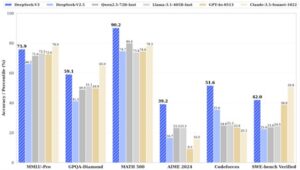In a remarkable turn of events, the AI landscape has been shaken by the emergence of DeepSeek, a Chinese startup headquartered in Hangzhou, Zhejiang province, China.
This relatively unknown player has suddenly become a name on everyone’s lips, challenging industry giants and reshaping the AI development paradigm.
The Rise of DeepSeek
DeepSeek’s controlling shareholder is Liang Wenfeng, who co-founded High-Flyer, a quantitative hedge fund, in 2015. In 2023, Liang announced High-Flyer would pursue the development of artificial general intelligence and launched DeepSeek. Liang Wenfeng has been dubbed “THE SAM ALTMAN OF CHINA” due to his influential role in the AI sector.
The company has been grabbing headlines for several reasons, including the release of their R1 language model on January 20, 2025, which reportedly matches GPT-4’s performance at a fraction of the cost. Additionally, DeepSeek AI Assistant dethroned ChatGPT as the most downloaded free app on Apple’s App Store in the United States. The company also introduced Janus Pro, a new multimodal AI model family that challenges industry leaders like OpenAI’s DALL-E 3.
Impressive Performance and Efficiency

DeepSeek reported that their Deepseek v3 model, which was used to build the Deepseek-R1 model, have demonstrated competitive performance in various evaluations. While exact figures vary, internal benchmarks indicate that the DeepSeek-R1 model competes with leading proprietary and open-source models such as Meta’s Llama 3, Anthropic’s Claude Sonnet 3.5, and OpenAI’s GPT-4. Notable achievements include MATH 500 Benchmark –Achieved a high accuracy rate, demonstrating strong mathematical reasoning capabilities, AI Math Evaluation Coding – Performed competitively in AI math-related programming tasks, though exact comparison data with top models is still emerging and, Coding Competition Benchmarks – Scored well in solving algorithmic coding problems, positioning itself among the strongest AI coding models available.
Cost Efficiency
DeepSeek’s breakthrough in cost-efficient AI development has garnered significant attention and positioned the company as a game-changer in the industry. The company reports that DeepSeek-V3, the foundation for DeepSeek-R1, was trained for under $6 million USD, a fraction of what competitors spend. Unlike Western AI giants that invest hundreds of millions into models like GPT-4 or Gemini, DeepSeek has redefined efficiency without compromising performance. By leveraging optimized architectures and innovative training techniques, DeepSeek delivers top-tier AI capabilities at a dramatically lower cost, making cutting-edge AI more accessible, scalable, and cost-effective than ever before.
However, where DeepSeek-R1 truly stands out is in operational efficiency. Its API pricing is significantly more affordable, at $0.55 per million input tokens and $2.19 per million output tokens. In comparison, DeepSeek-R1 is reported to be 27 times cheaper than OpenAI’s o1 model at the largest scale. This affordability translates directly to users, with estimates suggesting that DeepSeek-R1 could cost just 2% of what users would typically spend on OpenAI’s o1 model for similar tasks.
Market Impact and Industry Reaction
The emergence of DeepSeek has had a profound impact on the technology sector, causing significant shifts in market shares among established industry leaders. One of the most striking effects was seen in Nvidia, whose stock experienced a sharp decline, with its market capitalization dropping by approximately $600 billion in a single day.
Similarly, Oracle’s stock plunged by 13.8% on January 27, 2025, reflecting investor concerns over increasing competition in AI-driven infrastructure. Even Amazon, a dominant force in cloud computing and AI services, saw a 2.5% decline in stock value, signalling market uncertainty as DeepSeek’s advancements continue to disrupt traditional AI business models. These fluctuations highlight the growing influence of DeepSeek, raising questions about how industry giants will adapt to the evolving AI landscape.
Impact on Data Centers and Energy Consumption
DeepSeek’s achievements have raised questions about the future of data centers and energy consumption in AI. The R1 model’s efficiency suggests that data centers may no longer require extensive high-GPU setups to train advanced AI models.
This could lead to a decrease in demand for large-scale data center infrastructures traditionally used for AI training and inference. Some routine AI queries might not need a data center and could be shifted to edge devices, potentially reducing overall energy consumption.
Janus Pro: A Game-Changing Multimodal Model
DeepSeek released its Janus Pro AI model on January 27, 2025. This open-source multimodal model is designed for both text and image generation, with configurations of 1 billion and 7 billion parameters.
According to DeepSeek’s internal tests, Janus Pro outperforms well-known models like DALL-E 3, Pixar Alpha, and EMU3 on benchmarks such as GenEval and DPG-Bench. The Janus Pro 7B model achieved a score of 0.80 on the GenEval benchmark, surpassing DALL-E 3’s score of 0.67. Unlike companies like OpenAI that keep their models proprietary, DeepSeek has released Janus Pro as open-source, making the model’s code and weights available on Hugging Face for anyone to download and use.
Challenges and Controversies
Despite its success, DeepSeek has faced significant challenges. The company has had difficulty accessing advanced GPU chips due to U.S. export restrictions. However, they have leveraged alternative strategies, such as using domestically produced chips or less advanced GPUs.
On January 27, 2025, DeepSeek faced a large-scale cyberattack, disrupting new user registrations. Days after the allegations, the company continues to face service issues. Some critics worry about possible security risks and question whether DeepSeek might be closely tied to the Chinese government. It is worth noting that DeepSeek’s models adhere to Chinese censorship policies, which affects their responses on certain topics.
Looking Ahead
DeepSeek’s rise demonstrates that AI innovation is no longer limited to Silicon Valley. By prioritizing open-source accessibility and cost-efficiency, DeepSeek is reshaping the AI landscape, creating a ripple effect that forces industry leaders to rethink their strategies. As the AI race intensifies, it remains to be seen whether DeepSeek’s success is sustainable or just a flash in the pan. One thing is certain: DeepSeek’s sudden rise is a reality check for the billions poured into AI by West Coast giants, changing the entire conversation around AI dominance, impacting stock prices, investment trends, and even how governments think about export controls.
Watch the Video here:
@dylan.page What do you guys think about China’s new DeepSeek AI? 🤔😳
More from Wake Up Singapore:-
Technology’s Impact on Poultry Farming: From Artificial Insemination to Artificial Intelligence
AI : UK’s first Teacherless classroom have started for GCSE students
If you have a story or a tip-off, email admin@wakeup.sg or get in touch via Whatsapp at 8882 5913.
Since you have made it to the end of the article, follow Wake Up Singapore on Telegram!
Wake Up Singapore is a volunteer-run site that covers alternative views in Singapore. If you want to volunteer with us, sign up here!
If you can, please do consider buying a mug or two to support Wake Up Singapore’s work!







